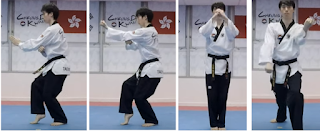I've written in the past that despite coming from an ITF-offshoot, I'm a fan of the WT black belt poomsae. I think the KTA committee did a good job of created a small number of patterns that are not too complex but still capture a variety of karate movements and fighting applications.
But what about their color belt poomsae, the Taegeuks? Online, these patterns are not well-loved. Criticism of them include:
- They are repetitive
- They rely too much on basic movements and lack depth
- They lack power due to the short stance
- They are inferior to the original WT color belt poomsae, the Palgwe series
Most of this criticism applies to Taegeuks 1-6. Taeguek 7 is considerably more complex than the previous patterns and contains techniques not even found in the black belt poomsae. Taegeuk 8 is more dynamic and includes the double front kick, which no other ITF or WT pattern has.
 |
| Taeguek 7 is considerably more complex than Taeguek 6. Performance by Woo Taekwon |
What are my opinions on the Taegueks?
I actually like Taegeuk 1 as an introductory pattern. Not only does it allow the student to practice some basic movements, it has some practical application as well. It's often asked if the Taegueks have any "real" applications, to which I say of course they do. All patterns have applications, although there is a question of how realistic they are.
Take the opening set of Taeguek 1.
 |
| Performed by Woo Taekwon |
You may use this simply to:
- Parry-pass low, so you are outside the opponent's right arm
- Grab and pull the arm while punching the opponent.
- Use the turn into the front stance low block as a throw. Aid the throw by punching down with the reverse punch.
How does Taeguek 1 stack against the first ITF pattern, Chon-Ji? I think Taeguek 1 has a little more to offer in terms of applications, due to having more techniques. While Chon-Ji has applications, it's more valuable as a barometer of the student's abilities. (Are they utilizing their hips and core? Are they breathing right? Are they relaxing between blocks and tensing during blocks, etc. )
I also kind of like Taegeuks 7 and 8 for the reasons described above. They feel like real patterns in their own right rather than simplified beginner patterns.
 |
| Ko soto gari, an application for the opening move of Taegeuk 7 |
But then you have Taegueks 2 through 6, which remain awfully simple. Taegeuk 2 seems wholly unnecessary to me; its sets are variations of Taegeuk 1. Taeguek 3 does add on some knifehand techniques, Taegeuk 4 the "swallow form", and Taeguek 5 some elbow strikes. Taeguek 6 is the only WT poomsae to contain a roundhouse kick, but is otherwise pretty basic.
If I had to describe the purpose of the first 6 Taegueks, it would be to slowly build in complexity to the higher poomsae and provide the student with logical applications of basic movements. Five of the eight Taegueks begin with a low block, as do four of the eight Palgwe. They make frequent use of the inward block (in ITF: front block), a technique rare in both ITF and karate patterns.
 |
| Ørjan Nilsen applying the inward block (see below video) |
This block was also used, to a lesser extent, in the Palgwe. Applications of this "block" include striking the elbow, a front backfist strike, and getting an underhook.
Let's look at the second set of Taeguek 1. If the throw from set 1 fails, you may lock the opponent's right elbow as shown in the image. Follow with a step into a reverse punch to the back of the head. Simple, but it can work.
Simon John O'Neill wrote a book called The Taegeuk Cipher in which he argues the Taegueks can serve as a self-defense syllabus. He writes,
The eight Taegueks summarize the fundamental self-defense methods of Kukki Taekwondo, providing a complete systems which at [an] advanced level may be supplemented by skills from the more specialized Black Belt poomses. The Taegeuk set may be further broken down into three subsets. Of these, the first [Taegeuks 1-3] deals chiefly with the initial stages of a violent encounter, after the opportunity for a successful pre-emptive strike has been lost, but before full grappling commences. The second subset [Taegeuks 4-6] is mainly concerned with the stage of a fight in which longer range methods have given way to infighting or clinching, as well as showing more sophisticated ways of dealing with strikes and grabs. The last subset [Taegeuks 7-8] examines responses to less common attacks, as well as a providing alternatives to the methods taught by the first six patterns, introducing more advanced techniques.
Do I agree with O'Neill? Not completely, but he probably knows the patterns better than I do. He analyzes the Taegeuks as collections of disconnected sets, whereas I see them (like most patterns) as fights against a single opponent. I do agree that you can break the Taegueks into those three subsets based on complexity.
Ørjan Nilsen over at Traditional Taekwondo Ramblings has done much analysis of the Taegeuks. Below is his interpretation of Taegeuk 4.
If you train ITF, are the Taegeuks worth picking up?
I say not really, since ITF has its own beginner patterns. Taegueks 7 and 8 may have some value for their unique techniques, and learning a few applications for the front block can be useful. But I don't think the Taegeuks are bad, just simple. Taegeuks 2-6 could probably be collapsed into one or two patterns. They definitely were made with applications in mind, unless you believe those odd movements in Taegeuk 7 are just randomly arranged.
No comments:
Post a Comment